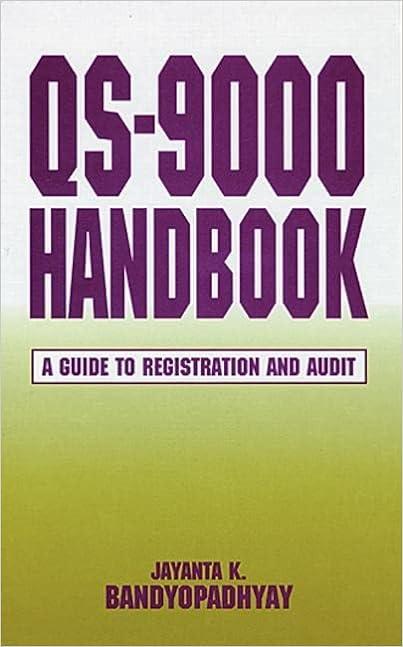Question
A parent company acquired 100 percent of the stock of a subsidiary company on January 1, 2013, for $800,000. On this date, the balances of
A parent company acquired 100 percent of the stock of a subsidiary company on January 1, 2013, for $800,000. On this date, the balances of the subsidiarys stockholders equity accounts were Common Stock, $50,000, Additional Paid-in Capital, $55,000, and Retained Earnings, $195,000. On the acquisition date, the excess was assigned to the following AAP assets:
| Original Amount | Original Useful Life | |||||||
|---|---|---|---|---|---|---|---|---|
| Property, plant & equipment | 250,000 | 10 | years | |||||
| Customer list | 150,000 | 8 | years | |||||
| Royalty agreement | 130,000 | 8 | years | |||||
| Goodwill | 120,000 | Indefinite | ||||||
The Goodwill asset has been tested annually for impairment, and has not been found to be impaired.
Assume that the parent company sells inventory to its wholly owned subsidiary. The subsidiary, ultimately, sells the inventory to customers outside of the consolidated group. You have compiled the following data for the years ending 2015 and 2016:
| Intercompany Sales | Gross Profit Remaining in Unsold Inventory | Receivable (Payable) | |||||
|---|---|---|---|---|---|---|---|
| 2016 | $42,000 | $10,000 | $30,000 | ||||
| 2015 | $62,000 | $12,500 | $17,000 | ||||
The inventory not remaining at the end of a given year is sold to unaffiliated entities outside of the consolidated group during the next year. The parent uses the cost method of pre-consolidation Equity Investment bookkeeping.
The financial statements of the parent and its subsidiary for the year ended December 31, 2016, follow:
| Parent | Subsidiary | Parent | Subsidiary | ||||||||||||||
|---|---|---|---|---|---|---|---|---|---|---|---|---|---|---|---|---|---|
| Income statement | Balance sheet | ||||||||||||||||
| Sales | $4,350,000 | $800,000 | Assets | ||||||||||||||
| Cost of goods sold | (3,050,000) | (480,000) | Cash | $650,000 | 300,000 | ||||||||||||
| Gross profit | 1,300,000 | 320,000 | Accounts receivable | 560,000 | 180,000 | ||||||||||||
| Income (loss) from subsidiary | 15,000 | - | Inventory | 850,000 | 250,000 | ||||||||||||
| Operating expenses | (830,000) | (200,000) | Equity investment | 950,000 | - | ||||||||||||
| Net income | 485,000 | 120,000 | Property, plant & equipment | 4,000,000 | 420,000 | ||||||||||||
| Statement of retained earnings | $7,010,000 | $1,150,000 | |||||||||||||||
| BOY retained earnings | $2,000,000 | 455,000 | Liabilities and stockholders' equity | ||||||||||||||
| Net income | 485,000 | 120,000 | Accounts payable | $350,000 | $100,000 | ||||||||||||
| Dividends | (125,000) | (15,000) | Other current liabilities | 400,000 | 125,000 | ||||||||||||
| Ending retained earnings | $2,360,000 | 560,000 | Long-term liabilities | 2,500,000 | 260,000 | ||||||||||||
| Common stock | 700,000 | 50,000 | |||||||||||||||
| APIC | 700,000 | 55,000 | |||||||||||||||
| Retained earnings | 2,360,000 | 560,000 | |||||||||||||||
|
| 7,010,000 | 1,150,000 | |||||||||||||||
| Parent | Subsidiary | ||||
| Income statement | |||||
| Sales | $4,350,000 | $800,000 | |||
| Cost of goods sold | -3,050,000 | -480,000 | |||
| Gross profit | 1,300,000 | 320,000 | |||
| Equity income | 15,000 | - | |||
| Operating expenses | -830,000 | -200,000 | |||
| Net income | $485,000 | $120,000 | |||
| Statement of retained earnings | |||||
| BOY retained earnings | $2,000,000 | $405,000 | |||
| Net income | 485,000 | 120,000 | |||
| Dividends | -125,000 | -15,000 | |||
| Ending retained earnings | $2,360,000 | $510,000 | |||
| Balance sheet | |||||
| Assets | |||||
| Cash | $650,000 | 300,000 | |||
| Accounts receivable | 560,000 | 180,000 | |||
| Inventory | 850,000 | 250,000 | |||
| Equity investment | 950,000 | - | |||
| PPE, net | 4,000,000 | 420,000 | |||
| Customer List | |||||
| Royalty Agreement | |||||
| Goodwill | |||||
| 7,010,000 | 1,150,000 | ||||
| Liabilities and equity | |||||
| Accounts payable | $350,000 | $100,000 | |||
| Other current liabilities | 400,000 | 125,000 | |||
| Long-term liabilities | 2,500,000 | 260,000 | |||
| Common stock | 700,000 | 50,000 | |||
| APIC | 700,000 | 55,000 | |||
| Retained earnings | 2,360,000 | 560,000 | |||
| 7,010,000 | 1,150,000 | ||||
b. Compute the amount of the beginning of year [ADJ] adjustment necessary for the consolidation of the financial statements for the year ended December 31, 2016.
Do not use negative signs with your answers below.
| Change in RE(S) thru BOY | ||
| Cumulative AAP amort thru BOY | ||
| BOY Upstream IIP | ||
| ADJ Amount | ||
Step by Step Solution
There are 3 Steps involved in it
Step: 1

Get Instant Access to Expert-Tailored Solutions
See step-by-step solutions with expert insights and AI powered tools for academic success
Step: 2

Step: 3

Ace Your Homework with AI
Get the answers you need in no time with our AI-driven, step-by-step assistance
Get Started


